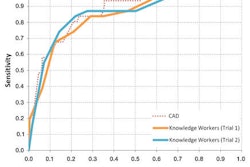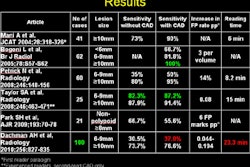Computer-aided detection (CAD) used concurrently with the first reading of a virtual colonoscopy study offers diagnostic performance similar to that of the conventional interpretation paradigm, in which CAD is used as a second reader following unassisted interpretation by the radiologist, say researchers in Turin, Italy.
Reading virtual colonoscopy (also known as CT colonography or CTC) studies is not only time-consuming, it also costs money and requires experienced staff, both of which are in short supply. Nevertheless, radiologists are understandably wary of letting CAD software take the first look at CT findings in any anatomic region.
After all, conventional wisdom and a few research studies have suggested that reading CAD results while interpreting a first-read exam risks relying too much on the algorithm to find suspicious lesions -- and putting less effort into finding them unaided. But Dr. Gabriella Iussich, Dr. Daniele Regge, and colleagues from the University of Turin found no significant differences between the two paradigms in a study at their hospital.
"We think that our new CAD first-reading scenario is more time-efficient and has similar diagnostic performance to CAD as a second reader," Iussich said in a talk at the European Congress of Radiology (ECR) in March. The optimal reading paradigm for CAD still isn't clear, even though a few studies have suggested that using CAD as a second reader is superior. Among the unknowns is the CAD miss rate, especially with flat lesions. So, the researchers decided to investigate CAD in a first-reader scenario.
"CAD has a good standalone performance, about 90% per-patient sensitivity, and it reduces reading time, so it's attractive in the screening setting," Iussich.
The study involved an analysis of 182 individuals participating in a colorectal cancer screening program, who were recruited for same-day CTC and optical colonoscopy. All patients underwent standard cathartic bowel cleansing. Patients had positive fecal occult blood tests (FOBT) and underwent full bowel purgation, Iussich said. On the same day as CTC they were given hydrocolon therapy and segmentally unblinded optical colonoscopy.
Two experienced radiologists independently analyzed the CTC studies following randomization, viewing them with CAD (im3D) as either a first (CAD1) or second (CAD2) reader, then reading each case using the other method, such that each case was read by each reader in both reading paradigms. The team assigned confidence levels to positive findings, measuring reporting time and per-patient sensitivity for patients with adenomas or colorectal cancers 6 mm and larger. They measured specificity for both methods, along with relative 95% confidence intervals (CI).
Of the 182 patients, 89 were negative, including 58 with no colorectal lesion, six with advanced adenomas 5 mm or smaller, 17 with low-risk adenomas 5 mm or smaller, and eight with nonadenomatous lesions.
A total of 93 patients were positive, including 13 with cancers larger than 1 cm, 14 with advanced adenomas 1 cm or larger, 15 with advanced adenomas 6 to 9 mm, and 17 with low-risk adenomas 6 to 9 mm.
Sensitivity with CAD as a second reader was 86% (95% CI: 77%-92%); with CAD as a first reader, it was 89% (95% CI: 81%-95%) (p = 0.05). There was no significant difference in specificity between CAD2 and CAD1 [90% (80/89) (95% CI: 81%-95%) versus 91% (81/89) (95% CI: 83%-96%)].
CAD as first reader versus second reader
|
||||||||||||||||||||||||||||||
| PPV = positive predictive value; AUC = area under the curve. | ||||||||||||||||||||||||||||||
The mean areas under the curve (AUCs) for CAD2 and CAD1 were similar (p = 0.09). "Areas under curves for both paradigms are higher for [CAD]-assisted reading, and there is no difference between the two, so that helps us," Iussich said.
The effect of the CAD paradigm on polyp detection was not significant (p = 0.8). However, the likelihood of a polyp being correctly detected by readers increased with the lesion diameter (p = 0.03). Small advanced adenomas were more likely to be detected after CAD prompting than low-risk adenomas (p = 0.01).
"Even though we see very well the advanced adenomas, we still don't recognize low-risk adenomas even when prompted by the CAD," she said. "And even though we detected polyps 9 mm and larger, polyps in the 6-9-mm category we still don't recognize even when prompted correctly by the CAD."
Finally, CAD as a first reader was faster. CAD1 reading time (six minutes, two seconds ± 55 sec) was two minutes shorter than CAD2 reading time (eight minutes, seven seconds ± 30 sec; p = 0.008).
"Reporting times also depend on the number of CAD markings," Iussich said. "If we have more than 20 CAD prompts, we have high reported reading times. If we have fewer than 20 prompts, the reading time is still comparable to the unassisted reads. If we have more than 10 CAD prompts, our reading time is higher and is not comparable with unassisted reading."
The use of CAD improves per-patient and per-polyp detection without a significant decrease in specificity, Iussich said. "We think that our new CAD first-reading scenario is more time-efficient and has similar diagnostic performance to CAD as a second reader. We are currently using [CAD as a first reader] for our screening program, where cost-effectiveness is an issue and we don't have so many experienced radiologists."




















